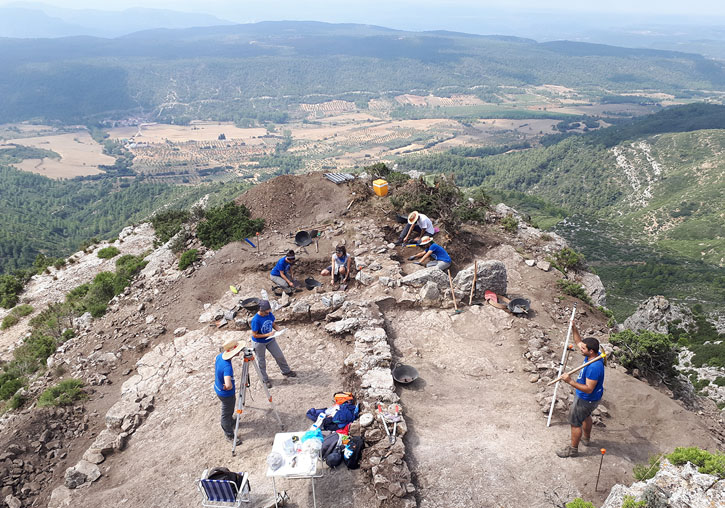The first Iberian lead plate found in a regulated excavation in the Pico de los Ajos in Yátova is in archaic writing
- Scientific Culture and Innovation Unit
- June 11st, 2021

A multidisciplinary research team from the University of Valencia (UV), the Museum of Prehistory of Valencia (MPV) and the University of Barcelona (UB) has published a study in which they discover and interpret a lead plate with Iberian writing, the first obtained in a regulated excavation in Pico de los Ajos (Yátova), one of the most important Iberian sites. This sheet, of archaic writing and an unknown theme, has indeed been able to be phonetically transcribed and advances in the knowledge of Iberian culture.
Many of the lead sheets come from looting and not from regulated excavations. Thus, the plate studied by the research group that includes Consuelo Mata, David Quixal and Gianni Gallello, from the Department of Prehistory, Archaeology and Ancient History, and Ana Serrano, a graduate of the Master of Archaeology at the UV, represents one of the few and the first from this site to be obtained in an excavation. Thanks to this, it has been possible to study it within a known context, both temporal and spatial. The study has been published in the journal Veleia.
The lead plate was found bent on itself and, after cleaning and adapting it in the MPV, it could be interpreted palaeographically by specialists Joan Ferrer and Javier Velaza, from the UB. Written on both sides and forming a single text, Iberian symbols of known sound can be identified. In addition, it stands out that it was written between the fourth and third centuries BC, while other similar plates generally date from later centuries. The interesting thing is that its archaeological find has occurred in a later context, from the second and fist centuries BC, at which time lead had lost its original function and was just another metal to be recycled, along with other metal tools. Regarding the subject matter of the text, its commercial or administrative nature is ruled out, so one hypothesis is that it could be a religious text.
“This site has one of the largest sets of texts written in Iberian on the entire peninsula”, says David Quixal. The sheets of lead used as writing support are relatively common in the deposits of the Iberian culture. The Pico de los Ajos, a town located in the town of Yátova, was inhabited at least since the 7th century BC. and later abandoned between the first century BC and first AC.
However, although it has been studied phonetically, the message contained in this sheet is not clear and, therefore, neither is the context in which it should be placed. “Iberian is a language that still cannot be translated, but in which experts progress little by little in the identification of words and this helps to interpret what type of texts they were”, explains David Quixal, professor of Archaeology and one of the authors of the article. In fact, in this lead it has been possible to identify with quite certainty the name of a person, tořaibeleś, presumably the author of the text or whoever commissioned it.
Article: Ferrer i Jané, Joan; Quixal Santos, David; Velaza Frías, Javier; Serrano Castellano, Ana; Mata Parreño, Consuelo; Pasíes Oviedo, Trinidad; Gallello, Gianni (2021), «Una pequeña lámina de plomo con inscripción ibérica de paleografía arcaica del Pico de los Ajos (Yátova, València)», Veleia, 38, 91-109. DOI: https://doi.org/10.1387/veleia.22508
Photo caption:
Excavation of the Pico de los Ajos.



















